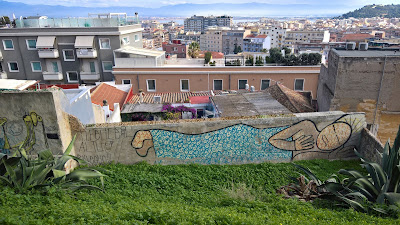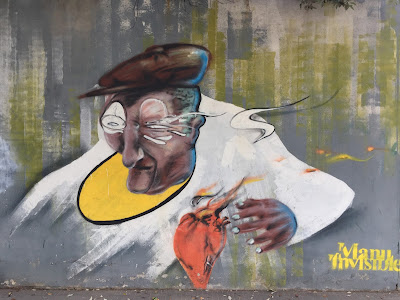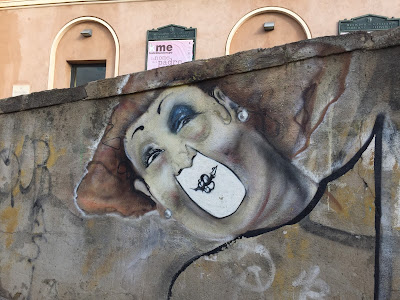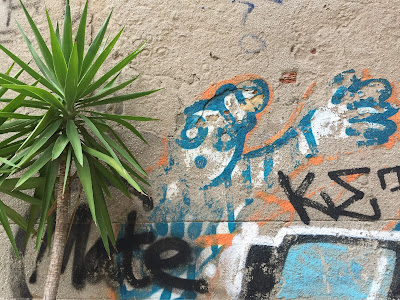In this episode of Street Sign Language Lesson (the first of 2017), we’ll ponder
dado in PAM, investigate the etymology of
via Pelabrocco, learn the word
groppone (not a big Groupon) as well as other signs that reveal a little something about our everyday life in Bergamo.
Left: Schizza e strappa in PAM. Center: Example of "dado" or bouillon cubes. Right: Writing on a plastic bag explaining the bag can be composted.


 Schizza e strappa – Sketch and tear off
Schizza e strappa – Sketch and tear off
While in the PAM grocery store, I saw these sketchpads and liked the phrase
schizza e strappa. It reminded me of a previous lesson when we talked about
stacca e attacca. The verbs are
schizzare – to sketch, and
stappare – to tear off, here are used in the informal imperative “you” to render the phrase.
Schizzo e strappo also would make sense; they are the related respective nouns “a sketch” and “a tear”.
Il mio dado – My bouillon cube
While in PAM again*, it finally dawned on me that
dado is used for die/dice and bouillon cubes. It’s the shape dummy!
* Just to set the record straight, we go to PAM for rice milk, peanuts, Fage yogurt, and cereal. The rest of our groceries we get from local vendors. We believe in shopping not just at the local big’ish grocery store.
Riutilizza questo sacchetto per la raccolta dei rifiuti compostabile – Reuse this bag for compostable waste
One day we were in the cortile and met the sisters Maria and Lidia. They live on the first floor and always have the lowdown on what’s going on in the condominium*. We got to talking about trash (in Italian) and we learned that the bags that you get in most stores (including PAM) are biodegradable. What the heck!? We never noticed that and in fact were buying special bags to use in our compost can. Sure enough, if you look closely on the bag, it’s written there. I think that’s pretty cool. In our condominium we separate plastics, paper, compost, and everything else.
* Condominium sounds like we live in Boca Raton or similar; it doesn’t do justice to the building we live in. Our “palazzo” was built in the 15
th or 16
th century and has a lot of scars and beauty, not to mention interesting people.
Left: Cover of the book Le Vie di Bergamo. Center: A page from the book Le Vie di Bergamo talking about via Pelabrocco. Right: A sign on via Pelabrocco announcing that someone looking to buy an apartment in the area.


 Le vie di Bergamo: Pelabrocco – The Streets of Bergamo: Pelabrocco
Le vie di Bergamo: Pelabrocco – The Streets of Bergamo: Pelabrocco
We live on
via Pelabrocco. I’m always fascinated with street names and
Pelabrocco is no exception. As soon as I could, during our morning coffee-talk time at Caffè Papavero, I would ask people about the name of the street. In terms of the name, we heard something like this:
pela is from
pelare – peel or skin, and
brocco is a dialect version of
zoccolo - hoof. The street was steep and tough on the hooves of the animals that carried goods on the street. Okay, we bought that even if it seemed a little too literal.
Recently, we were in the
Biblioteca Angela Mai (the best place to study) and the book:
Le vie di Bergamo – Streets of Bergamo caught our eye. We just had to take a look to see what it said about
via Pelabrocco. According to the book (and after a translation):
Before the construction of the Venetian walls, this street connected via Pignolo with via Osmano, leading directly to Città Alta. The name “de Pelabrochis” is that of an existing family of Bergamo in the 15th and 16th centuries. This is recalled by Federico, archpriest (but one step below for large diocese) and the general vicar of the church of Bergamo and the Italian historian Giovanni Battista Angelini.
We also knew from visits to the local museums that
Pelabrocco once went up to the upper city so that part of the description made sense. But “recalled” by a priest and an historian isn’t much better than the story I heard at the café down the street. I'm going with tired hooves.
There is also a
vicolo Pelabrocco nearby. At one time, it connected to
via Pelabrocco, but now is only accessible from
Viale Vittorio Emanuele II. The first day we arrived over a year ago, the taxi driver left us on
vicolo Pelabrocco and it took us a while to figure out the problem.
Cerco in zono, appartamento in acquisto – Looking for an apartment to buy in the area
Speaking of
via Pelabrocco, we saw this sign announcing that someone was looking to buy an apartment in the area. Maybe it's someone from the
de Pelabrochis family, back to live on the street that bears their name.
Left: A telephone booth scheduled to be removed. Center: A list "cronotassi" of bishops of Bergamo. Right: A poster for the recent referendum.


 Questa cabina sarà rimossa – This booth will be removed
Questa cabina sarà rimossa – This booth will be removed
This phone booth was on
Viale delle Mura, near La Marianna in Città Alta. (The gelato flavor
stracciatella was invented in 1962 by the owner of La Marianna.) Another phone booth bites the dust? The thing about the sign here is that it was posted in June 2016, the removal was for August, and we took the picture in November. Maybe someone was making a call the day they showed up to remove the booth and they called it off.
Rimossa is the past participle of the verb
rimuovere - remove or take away. It has “a” ending to match gender with
cabina.
Sarà is the future form of the verb
essere – to be.
Cronotassi dei vescovi di Bergamo – List of bishops of Bergamo
I’m interested in words that the dictionary on my phone has no ideas about and
cronotassi was one of them. It is a chronological list of people who held a position, typically used in the succession of bishops. And fittingly, we saw this in the Duomo of Bergamo (La Cattedrale di Sant’Alessandro), in the crypt.
Una riforma che ci resta sul groppone – A reform is left on our shoulders
The referendum (
Italian constitutional referendum, 2016) went down in defeat 59% no to 41% yes. The region of Lombardy voted 55% no, but Bergamo voted for it with 53% yes.
It was interesting how a few weeks before the vote on December 4, 2016, numerous metal boards like the one pictured went up around town providing space for these political ads. We saw this sign on the
Parco della Fara (
La Fara). The image of a donkey (
asino in Italian) dressed in a sweat shirt caught my attention – it was designed to.
Groppone is the back of animal, used facetiously to refer to the shoulders or back of a person. Here the literal message is that if you vote yes, the result will be on your back. The subtler message is: vote no if you don’t want to be an ass.
The staff of l'Arte Caffe Torrefazione home sick for the day. Our loss.
 Chiuso ci spiace – staff influenzato – Sorry closed – staff has the flu
Chiuso ci spiace – staff influenzato – Sorry closed – staff has the flu
Another of our favorite cafés, l'Arte Caffe Torrefazione, presented us with this sign one Sunday morning. No, the staff wasn’t influenced; they had the flu.
Influenzare can mean to influence but it also means to have the flu, with
influenzato as the associated adjective. The sign below continues
chiuso, ci scusiamo a causa influenza generalizzata or “closed, we apologize, due to general flu”.



















































































































